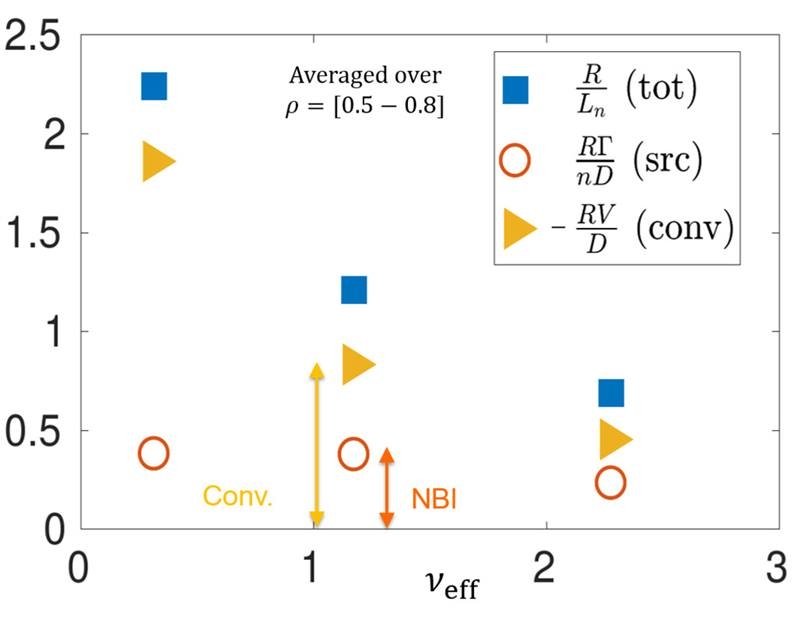The Science
In a fusion reactor, fusion occurs when deuterium and tritium in the plasma collide and fuse. These collisions are more likely when the electrons from the deuterium and tritium are more concentrated. High density plasma means more collisions. Scientists at the DIII-D National Fusion Facility have found that in high-confinement plasmas, the density in the center of the plasma rises naturally. They predicted this increase was the result of two possible mechanisms. Either it could result from deliberately injecting electrons into the plasma when the core is fueled. Or it could be due to turbulence in the plasma as it moves through the DIII-D tokamak. However, previous experiments could not separate these possible causes. In new experiments at DIII-D, researchers were able to separately measure the deposition of particles and turbulent transport. The research showed that the increase is the result of electrons being transported by turbulence up a hill of plasma density going from the edge to the core of the plasma.
The Impact
Doubling plasma density leads to four times more fusion. Scientists at DIII-D have discovered that this hypothesized density “peaking” effect is important and have significantly advanced the understanding of this process. The new findings solve a challenge created by how fusion reactors work: they cannot be fueled in the core where most fusion reactions occur. The new research reveals a path to increasing core plasma density without direct core fueling. This approach could result in improved fusion performance, raising the power output from the ITER international fusion project. The results advance fusion energy science and bring us closer to viable fusion power.
Summary
Scientists conducted experiments at DIII-D, a Department of Energy Office of Science user facility, to identify this density peaking effect. To do so, they had to strip out effects from particles being deposited in the core of the plasma by DIII-D’s particle beam heating systems. They did this by carefully observing plasma behavior with pulses of gas and seeing how it traveled through the plasma.
This work is an important confirmation of theoretical expectations of such peaking, and it provides a basis to refine models and develop projections for future fusion reactors. These techniques were also used to separate out the attractive “pinch” density peaking effects from the natural turbulent diffusion of particles away from the core. Diffusion arises because a peaked density in the core drives additional outward motion of particles (much as a compressed gas will move into a less dense area of a container).
DIII-D is equipped with many remote measurement systems to measure the turbulence itself. These provide powerful validation of state-of-the-art simulations of the turbulence and a basis for predictive turbulent transport models that balance the pinch with the dissipation, thus determining the density profile. These encouraging results show that even without core fueling, peaked density profiles are possible, which should have a positive impact on the fusion power output of reactors.
Funding
This material is based on work supported by the Department of Energy Office of Science, Office of Fusion Energy Sciences, using the DIII-D National Fusion Facility, a DOE Office of Science user facility. This work has been carried out within the framework of the EUROfusion Consortium and has received funding from the Euratom research and training program.


